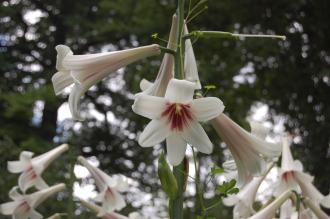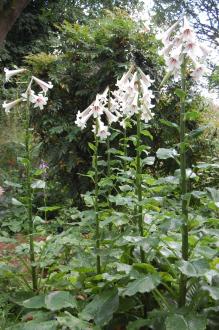
Cardiocrinum giganteum Flower (30/06/2012, Kew Gardens, London)
Position: Dappled shade
Flowering period: Summer
Soil: Moist, well drained
Eventual Height: 3m
Eventual Spread: 60cm
Hardiness: 7b – 9b
Family: Liliaceae
Sub Family: Lilioideae

Cardiocrinum giganteum (30/06/2012, Kew Gardens, London)
Cardiocrinum giganteum is a large, erect bulbous perennial. Its dark green glossy leaves are cordate with entire margins, are up to 35cm long and 30cm across and appears in rosette formation. Its fragrant white flowers are trumpet shaped, have a red throat, are up to 25cm long and appear in terminal racemes of up to 20 flowers on stems which are up to 2m tall. After flowering the individual bulb dies leaving offsets which flower in 3 to 5 years. Its roots emerge from a bulb which is up to 20cm across.
Cardiocrinum giganteum, commonly known as the Giant Himalayan Lilly or Giant Lilly, is native to the Himalayas. Cardiocrinum giganteumis synonymous Lilium giganteum himalaicum.
The etymological root of the binomial name Cardiocrinum is derived from the Greek kardia meaning ‘heart’ and krinon meaning ‘White Lilly’, the name meaning the White Lilly with heart shaped leaves. Giganteum is from the Latin meaning ‘like that of the Giants’.
The landscape architect may find Cardiocrinum giganteum useful for planting as part of a woodland scheme, for its erect, large fragrant flower.

Cardiocrinum giganteum Leaf (30/06/2012, Kew Gardens, London)
Ecologically, C. giganteum is attractive to pollinating insects.
C. giganteum prefers moist, fertile, deep, humus rich, well-drained soils. It tolerates most pH of soil. It will not tolerate water logging.
Cardiocrinum giganteum requires little maintenance.

